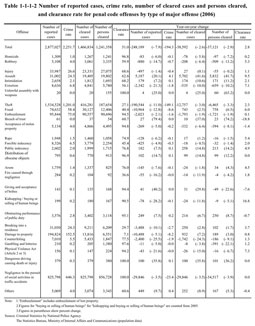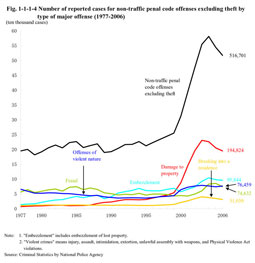| Previous Next Index Image Index Year Selection | |
|
|
1 Reported cases and crime rate
The number of cases reported for penal code offenses had continued registering a new post World War II (WWII) high every year from 1996, reaching 3,693,928 cases in 2002. However, the number turned to decline for the fourth consecutive year since 2003. In 2006, the number decreased by 248,189 (7.9%) from the previous year. Still, looking at the number of cases reported since post WWII, the number of reported cases remains at a considerably high level.
The number of cases reported for theft, which accounts for nearly 60% of overall reported cases of penal code offenses every year, has decreased from the previous year for four consecutive years since 2003 (see Chapter 1, Section 3 for details). This contributed to the decline of the total number of cases reported for penal code offenses. The number of cases reported for non-traffic penal code offenses excluding theft had been on a rise until 2004 but turned to decrease in 2005 and continued to decrease in 2006 as well. Table 1-1-1-2 shows the number of cases reported for penal code offenses by type of major offense and their crime rate in 2006, and Fig. 1-1-1-3 [1] shows the percent distribution by type of offense. The crime rate for penal code offenses has shown almost the same trend as the number of reported cases, registering a new post WWII high every year from 1998 (2,127.2) to 2002 (2,897.5), turning to decline in 2003, and it decreased every year after that. The rate was 2,251.7 in 2006 (down by 194.3 points from the previous year). The percent ratio by type of offense was the highest for theft, which accounts for 53.3%, followed by negligence in the pursuit of social activities in traffic accidents, damage to property, embezzlement (including embezzlement of lost property; hereinafter the same in this section), and fraud. Table 1-1-1-2 Number of reported cases, crime rate, number of cleared cases and persons cleared, and clearance rate for penal code offenses by type of major offense (2006) Fig. 1-1-1-3 Percent distribution of reported cases and persons cleared for penal code offenses, by type of offense (2006) Fig. 1-1-1-4 shows the trends in the number of reported cases by type of major offense, etc. in non-traffic penal code offenses excluding theft (over the last 30 years).Damage to property has increased rapidly since 2000 (see Chapter 1, Section 2, 6 for details), which is a factor to increase the number of reported cases in non-traffic penal code offenses excluding theft. In addition, the increase in embezzlement (in 2006, embezzlement of lost property accounted for 97.5% of embezzlement) and fraud (see Chapter 1, Section 2, 4 for details) also influenced the change in the number of reported cases of non-traffic penal code offenses excluding theft. Fig. 1-1-1-4 Number of reported cases for non-traffic penal code offenses excluding theft by type of major offense (1977-2006) |


